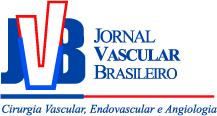Tratamento de varizes com laser endovenoso: estudo prospectivo com seguimento de 39 meses
Treatment of varicose veins with endovenous laser: a prospective 39-month follow-up study
Luiz Marcelo Aiello Viarengo; Guilherme Vieira Meirelles; João Potério Filho
Resumo
Palavras-chave
Abstract
Keywords
References
Maffei FH, Magaldi C, Pinho SZ. Varicose veins and chronic venous insufficiency in Brazil: prevalence among 1755 inhabitants of a country town. Int J Epidemiol.. 1986;15:210-7.
Bergan JJ, Ballard JI. Correction of superficial reflux. Atlas of endoscopic perforator vein surgery. 1998:98-103.
Lofgren EP, Lofgren KA. Recurrence of varicose veins after the stripping operation. Arch Surg.. 1971;102:111-4.
Dodd H, Cockett FB. The pathology and surgery of the veins of the lewer limb. 1976:210-4.
Davies AH, Steffen C, Cosgrove C, Wilkins DC. Varicose vein surgery: patient satisfaction. J R Coll Surg Edinb.. 1995;40:298-9.
Navarro L, Min RJ, Bone C. Endovenous Laser: a new minimally invasive method of treatment of varicose veins- preliminary observations using an 810 nm diode laser. Dermatol Surg.. 2001;27:117-22.
Proebstle TM, Lehr HA, Kargl A. Endovenous treatment of the greater saphenous vein with a 940-nm diode laser: thrombotic occlusion after endoluminal thermal damage by laser- generated steam bubbles. J Vasc Surg.. 2002;35:729-36.
Timperman PE, Sichlau M, Ryu RK. Greater energy delivery improves treatment success of endovenous laser treatment of incompetent saphenous veins. J Vasc Interv Radiol.. 2004;15:1061-3.
Dwerryhouse S, Davies B, Harradine K, Earnshaw JJ. Stripping the long saphenous vein reduces the rate of reoperation for recurrent varicose veins: five-year results of a randomized trial. J Vasc Surg.. 1999;29:589-92.
Manfrini S, Gasbarro V, Danielsson G. Endovenous management of saphenous vein reflux: Endovenous Reflux Management Study Group. J Vasc Surg.. 2000;32:330-42.
Glass GM. Neovascularisation in recurrence of the varicose great saphenous vein following transection. Phlebology. 1987;2:81-92.
Nyamekye I, Shephard NA, Davies B, Heather BP, Earnshaw JJ. Clinicopathological evidence that neovascularisation is a cause of recurrent varicose veins. Eur J Vasc Endovasc Surg.. 1998;15:412-5.
van Rij AM, Jones GT, Hill GB, Jiang P. Neovascularization and recurrent varicose veins: more histologic and ultrasound evidence. J Vasc Surg.. 2004;40:296-302.
Fischer R, Linde N, Duff C, Jeanneret C, Chandler JG, Seeber P. Late recurrent saphenofemoral junction reflux after ligation and stripping of the greater saphenous vein. J Vasc Surg.. 2001;34:236-40.
Creton D. Prosthetic material interposition on the crossectomy stump in varicose vein recurrence surgery: preliminary report on the prevention of angiogenesis. Scripta Phlebol.. 1998;6:4-7.
Glass GM. Prevention of saphenofemoral and saphenopopliteal recurrence of varicose veins by forming a partition to contain neovascularisation. Phebology. 1998;13:3-9.
Jakobsen BH. The value of different forms of treatment for varicose veins. Br J Surg.. 1979;66:182-4.
Proebstle TM, Gul D, Lehr HA, Kargl A, Knop J. Infrequent early recanalization of greater saphenous vein after endovenous laser treatment. J Vas Surg.. 2003;38:511-6.
Min RJ, Khilnani N, Zimmet SE. Endovenous laser treatment of saphenous vein reflux: long-term results. J Vasc Interv Radiol.. 2003;14:991-6.
Timperman PE. Arteriovenous fistula after endovenous laser treatment of the short saphenous vein. J Vasc Interv Radiol.. 2004;15:625-7.
Min RJ, Zimmet SE, Isaacs MN, Forrestal MD. Endovenous laser treatment of the incompetent greater saphenous vein. J Vasc Interv Radiol.. 2001;12:1167-71.
Gerard JL, Desgranges P, Becquemin JP, Desse H, Melliere D. Peut-on traiter les grandes saphénes variqueuses par laser endoveineaux en ambulatoire. J Mal Vasc.. 2002;27:222-5.
Chang CJ, Chua JJ. Endovenous laser photocoagulation (EVLP) for varicose veins. Lasers Surg Med.. 2002;31:257-62.
Oh CK, Jung DS, Jang HS, Kwon KS. Endovenous laser surgery of the incompetent greater saphenous vein with a 980 nm diode laser. Dermatol Surg.. 2003;29:1135-40.
Perkowski P, Ravi R, Gowda RC. Endovenous laser ablation of the saphenous vein for treatment of venous insufficiency and varicose veins: early results from a large single-center experience. J Endovasc Ther.. 2004;11:132-8.
Soracco JE, D'Ámbola JL, Ciucci JL, Godoy JMP, Belczak CEQ. Complicações no tratamento com laser endovascular em varizes de membros inferiores. J Vasc Bras.. 2005;4:333-5.
Mozes G, Kalra M, Carmo M, Swenson L, Gloviczki P. Extension of saphenous thrombus into the femoral vein: a potential complication of new endovenous ablation techniques. J Vasc Surg.. 2005;41:130-5.
Goldman MP, Mauricio M, Rao J. Intravascular 1320-nm laser closure of the great saphenous vein: a 6- to 12-month follow-up study. Dermatol Surg.. 2004;30:1380-5.
Proebstle TM, Moehler T, Gül D, Herdemann S. Endovenous treatment of the great saphenous vein using a 1,320 nm Nd: YAG laser causes fewer side effects than using a 940 nm diode laser. Dermatol Surg.. 2005;31:1678-83.
Agus GB, Mancini S, Magi G. The first 1000 cases of Italian Endovenous-Laser Working Group (IEWG): Rationale, and long-term outcomes for the 1999-2003 period. Int Angiol.. 2006;25:209-15.
Lisbona C, Pérez P, Segura J, Puncernau X. Laser surgery in venous insufficiency: E.L.A.V. personal technique. J Vasc Bras.. 2004;3:403-6.
Keith LM Jr., Smead WL. Saphenous vein stripping and its complications. Surg Clin North Am.. 1983;63:1303-12.
Lofgren EP, Coates HL, O'Brien PC. Clinically suspect pulmonary embolism after vein stripping. Mayo Clin Proc.. 1976;51:77-80.
Bounameaux H, Huber O. Postoperative deep vein thrombosis and surgery for varicose veins. BMJ.. 1996;312:1158.

